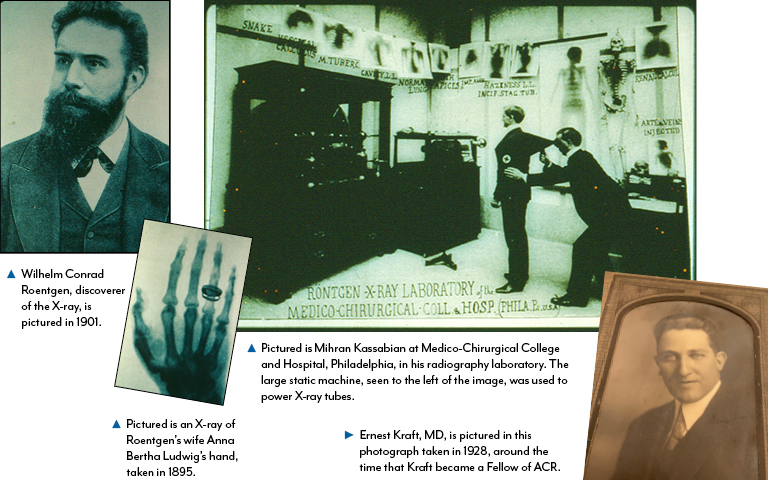With the ACR’s centennial year fast approaching, the Bulletin is looking back at the history of radiology and the people who shaped the specialty. To appreciate how far the specialty has come, we travel back to 1895 when physicist Wilhelm Conrad Roentgen’s invention of the X-ray changed everything. His discovery made waves in the scientific community. Ernest Kraft, MD, one of the ACR’s earliest members and fellows, studied under and assisted Roentgen in Germany and documented his experiences in his personal journal. His daughter, concert pianist Edith Kraft, was able to find a passage in her late father’s journal talking about his time with Roentgen. “Listening to Roentgen proved to be an inspiring experience,” wrote Ernest Kraft. “Unforgettable was a tumultuous applause when he demonstrated the fluorescent effect of the X-ray in the darkened hall. No teacher has made a more lasting impression on me. Roentgen has endeavored to guide his students toward a solid foundation, as he considered half-knowledge inferior to no knowledge at all.”
The discovery of the X-ray sparked a lot of interest in the scientific community. “In the beginning, no one really understood what was going on,” says Harry C. Knipp, MD, FACR, one of the founding members of Advanced Radiology. “The medical uses of the X-ray were picked up pretty quickly, but it was still a curiosity. Back then there were X-ray machines in arcades and there were X-ray clubs. Until people started getting illnesses, they didn’t realize that there might be some danger to this new discovery.”
The discovery made its way to the German press and eventually appeared in newspapers in America. Initial photographs in the press showed X-rays of a child’s hand, a frog, and a fish. From there, the X-ray quickly caught the attention and imagination of the public, according to Edward I. Bluth, MD, FACR, chair emeritus of the department of radiology at Ochsner Clinic Foundation. “As a result of all this general interest, there began to be public displays around the whole world,” says Bluth. “People were interested in seeing the first radiograph.”
Roetgen has endeavored to guide his students toward a solid foundation, as he considered half-knowledge inferior to no knowledge at all.
By 1910, the X-ray was being used within the medical field. However, much was still unknown about the new technology. According to Bluth, the first X-rays took anywhere from 20 minutes to an hour to complete, leaving the patient exposed to radiation for a long period of time. Further complicating its use, the X-ray was advertised to do and fix more than it was actually capable of. Bluth also mentioned how people advertised the X-ray to solve problems such as erectile dysfunction and infertility, further attracting people to the X-ray. In addition, many who operated the X-ray machines weren’t properly trained — there were no requirements to enroll in courses to operate the machine. Something needed to be done. “People didn’t realize right away that playing with these X-ray tubes, taking random pictures of things and body parts might have some unwanted effects,” Knipp says. “And after a couple of years, people who were playing with X-rays or even those using the technology in a practical way began to realize that skin lesions were developing from being exposed to radiation.”
As the exciting opportunities and potential dangers of X-rays emerged, it became clear that the field needed organization, leadership, and a vision for the future of medicine — something Edith Kraft believes her father Ernest understood. “As a professional, he was aware of the need for standardization, and for providing safe care for patients,” she says. “He approved of the founding ideals of the ACR to protect the integrity and to safeguard the patients. In those years, radiology was still in the making.” Knipp agrees, understanding the importance of what the ACR meant to radiology. “It was the first time that there was some recognition that we needed a body that could speak for radiology, not just scientifically, but politically and economically. One that would dignify the profession, develop organized residency programs, and help to support the creation of a specialty board.”

